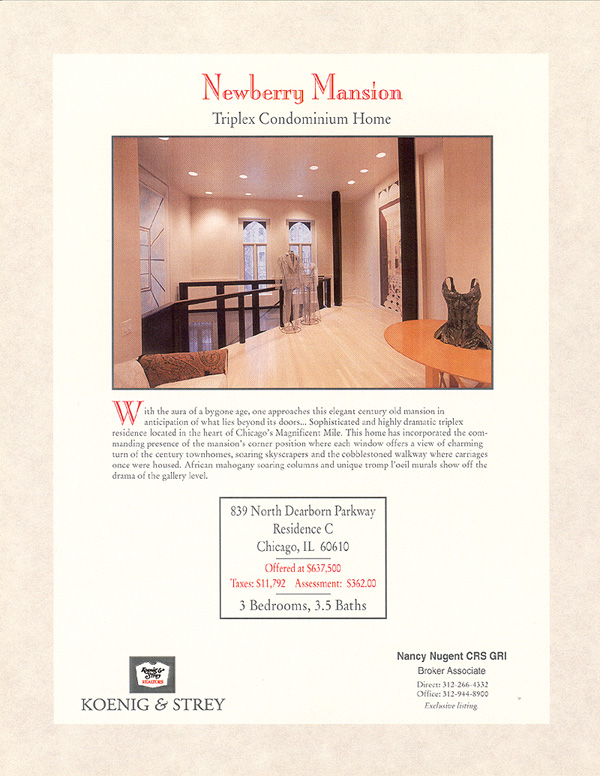
David J. Nims | Phone: 425-397-9814 | Fax: 425-397-0489 | nimsd@aol.com |
Upon my departure from Scenicsoft, I needed a break. The cash flow from my Scenicsoft agreement provided some flexibility. Benny Einhorn, who had replaced me as President of Optrotech, Inc., and had also been terminated by Orbot, had joined Indigo in Israel as V.P. Sales and Marketing. Indigo had recently launched a new, innovative, digital printing press, and were interested in learning more about the market potential for variable printing, where each copy printed was customized. Benny asked if I would do a market study for him, and I agreed. Under this study, I traveled extensively and looked at many different possible applications for variable printing.
One of the markets I looked at was the real estate market. I determined that because each individual real estate agent was responsible for designing and producing their own flyers, this would not be a good application for variable printing. However, it did seem to me that this would be a market for short-run digital printing, which the Indigo E-Print did very well. However, the design skills, and computer savvy of the typical real estate agents were not up to the level that would make this practical.
Nevertheless, in my opinion, clearly the real estate market needed to upgrade the level of design and print quality for their residential housing market. Most flyers produced for residential home sales were very shabby. So I began thinking about ways to deal with the design and production issues.
I finally arrived at a concept that I thought would work. On the design side, Scenicsoft had a product called Scenicwriter, a very powerful typesetting software engine. However, Scenicwriter had no user interface. My idea was to develop a user-friendly software program that would allow a real estate agent with virtually no design or computer skills to prepare flyers using pre-designed templates. The files produced, actually Scenicwriter code, would be copied to a diskette, and a purchase order would be printed out to be sent to the nearest Indigo print shop with which I had a relationship. At the print shops, I would install Scenicwriter, which would produce a Postscript file optimized for printing on the Indigo E-Print.
This concept seemed viable to me. I designed and printed a few sample flyers and discussed the concept with many real estate agents, and their brokers. The feedback I got was very positive. So I put together a business plan, started a new company, named Vertical Graphics, and got to work. I contracted out the development of the end-user software. This software, written in Visual Basic, was called Vertical HighFlyer. I also developed software for running Scenicwriter and automating the job handling at the printshops. This was a Microsoft Access application which I named Vertical Printshop.
Then I went looking for print shop partners. They were generally receptive to the concept. I signed up three printers to be beta sites for the product and concept: Widen Graphics in Madison, Wisconsin, Tukaiz Graphics in Chicago, and Banta Digital in Boston. The idea was that these companies would install Vertical HighFlyer in real estate offices at no charge and train the agents on its use. The print files and purchase orders, along with the pictures, would then be sent to the print shops, who would run Vertical Printshop to produce the production files, and would print the flyers on the E-Print. They would make money on the printing, and I would get a small percentage of their gross sales. Even the bookkeeping was automated.
All went well, at the beginning. Widen and Tukaiz, in particular, were both quite excited with the concept. In Chicago, one brokerage, Koenig & Strey, that specialized in high-end homes even paid to have a custom set of templates designed for their use. The agents easily learned how to use Vertical HighFlyer, and the flyers looked spectacular. Vertical Printshop automated the production process to the point that the Printshops could offer printing prices far below the prices they typically charged for similar short-run printing jobs.

|
However, the volume wasn't growing as expected. My objective was that in each area where HighFlyer was in use, the quality it produced would establish a new minimum accepted standard for quality, and that other realtors would be forced to adopt it. This level of penetration was not being achieved. The problem was price. At the low prices they were offering per print, the print shops needed to run at least 100 copies of each flyer to make the job worth running. The price of 100 single-sided, color flyers was $125. Using their old methods, pasting photos on poorly designed laser prints, realtors could make just the number of flyers they needed, and their outlay was in the $20-30 range. Despite what they told me during my market study, most realtors were not willing to pay the extra amount for higher quality ... even for high-end homes. There were many realtors who liked the product and quality, and they were steady customers. However, eventually it became clear to the printshops that their return on invested effort was not worth it and eventually they stopped promoting this application. With no marketing effort, the orders eventually dried up, and the print shops discontinued this service. Vertical Graphics quietly folded.